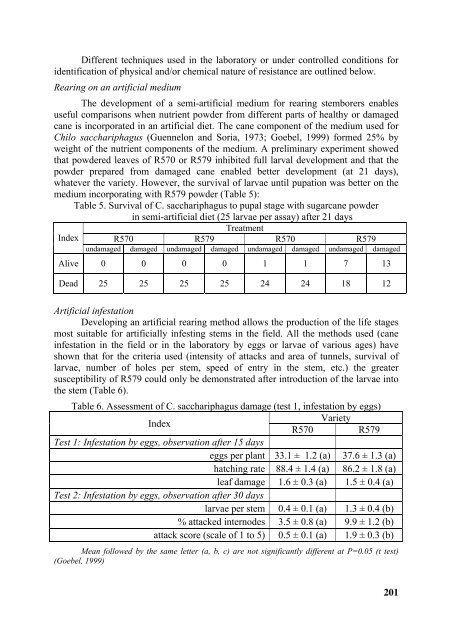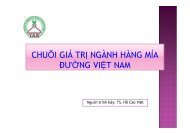TUYEÅN TAÄP
tuyeÃ¥n taäp - CHUYÃN TRANG GIá»I THIá»U CÃC GIá»NG MÃA Tá»T ...
tuyeÃ¥n taäp - CHUYÃN TRANG GIá»I THIá»U CÃC GIá»NG MÃA Tá»T ...
- No tags were found...
Create successful ePaper yourself
Turn your PDF publications into a flip-book with our unique Google optimized e-Paper software.
Different techniques used in the laboratory or under controlled conditions for<br />
identification of physical and/or chemical nature of resistance are outlined below.<br />
Rearing on an artificial medium<br />
The development of a semi-artificial medium for rearing stemborers enables<br />
useful comparisons when nutrient powder from different parts of healthy or damaged<br />
cane is incorporated in an artificial diet. The cane component of the medium used for<br />
Chilo sacchariphagus (Guennelon and Soria, 1973; Goebel, 1999) formed 25% by<br />
weight of the nutrient components of the medium. A preliminary experiment showed<br />
that powdered leaves of R570 or R579 inhibited full larval development and that the<br />
powder prepared from damaged cane enabled better development (at 21 days),<br />
whatever the variety. However, the survival of larvae until pupation was better on the<br />
medium incorporating with R579 powder (Table 5):<br />
Table 5. Survival of C. sacchariphagus to pupal stage with sugarcane powder<br />
in semi-artificial diet (25 larvae per assay) after 21 days<br />
Treatment<br />
Index R570 R579 R570 R579<br />
undamaged damaged undamaged damaged undamaged damaged undamaged damaged<br />
Alive 0 0 0 0 1 1 7 13<br />
Dead 25 25 25 25 24 24 18 12<br />
Artificial infestation<br />
Developing an artificial rearing method allows the production of the life stages<br />
most suitable for artificially infesting stems in the field. All the methods used (cane<br />
infestation in the field or in the laboratory by eggs or larvae of various ages) have<br />
shown that for the criteria used (intensity of attacks and area of tunnels, survival of<br />
larvae, number of holes per stem, speed of entry in the stem, etc.) the greater<br />
susceptibility of R579 could only be demonstrated after introduction of the larvae into<br />
the stem (Table 6).<br />
Table 6. Assessment of C. sacchariphagus damage (test 1, infestation by eggs)<br />
Index<br />
Variety<br />
R570 R579<br />
Test 1: Infestation by eggs, observation after 15 days<br />
eggs per plant 33.1 ± 1.2 (a) 37.6 ± 1.3 (a)<br />
hatching rate 88.4 ± 1.4 (a) 86.2 ± 1.8 (a)<br />
leaf damage 1.6 ± 0.3 (a) 1.5 ± 0.4 (a)<br />
Test 2: Infestation by eggs, observation after 30 days<br />
larvae per stem 0.4 ± 0.1 (a) 1.3 ± 0.4 (b)<br />
% attacked internodes 3.5 ± 0.8 (a) 9.9 ± 1.2 (b)<br />
attack score (scale of 1 to 5) 0.5 ± 0.1 (a) 1.9 ± 0.3 (b)<br />
Mean followed by the same letter (a, b, c) are not significantly different at P=0.05 (t test)<br />
(Goebel, 1999)<br />
201






